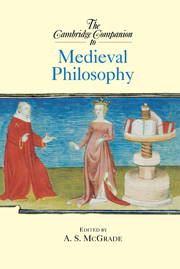Book contents
- Frontmatter
- Introduction
- 1 Medieval philosophy in context
- 2 Two medieval ideas: eternity and hierarchy
- 3 Language and logic
- 4 Philosophy in Islam
- 5 Jewish philosophy
- 6 Metaphysics: God and being
- 7 Creation and nature
- 8 Natures: the problem of universals
- 9 Human nature
- 10 The moral life
- 11 Ultimate goods: happiness, friendship, and bliss
- 12 Political philosophy
- 13 Medieval philosophy in later thought
- 14 Transmission and translation
- Chronology of philosophers and major events
- Biographies of Major Medieval Philosophers
- Bibliography
- Index
7 - Creation and nature
Published online by Cambridge University Press: 28 May 2006
- Frontmatter
- Introduction
- 1 Medieval philosophy in context
- 2 Two medieval ideas: eternity and hierarchy
- 3 Language and logic
- 4 Philosophy in Islam
- 5 Jewish philosophy
- 6 Metaphysics: God and being
- 7 Creation and nature
- 8 Natures: the problem of universals
- 9 Human nature
- 10 The moral life
- 11 Ultimate goods: happiness, friendship, and bliss
- 12 Political philosophy
- 13 Medieval philosophy in later thought
- 14 Transmission and translation
- Chronology of philosophers and major events
- Biographies of Major Medieval Philosophers
- Bibliography
- Index
Summary
Natural philosophy was “the most widely taught discipline at the medieval university.” We may get an idea of the extent of the subject in what has been called its classical century, 1277-1377, by looking at the contents of John Dumbleton's mid-fourteenth-century Summa of Logic and Natural Philosophy. After a first part on logic, the major headings are
II. First principles, matter and form; opinions about substantial forms; how qualities are intended and remitted.
III. On motion in the categories of place, quality, and quantity. On the causes of motion. How velocity is produced and caused. How alteration and augmentation are measured. The definitions of motion and time.
IV. On the nature of the elements and their qualities. If each element has two qualities in the highest degree. The action and reaction of elements on each other. The relations of elemental and qualitative forms. Density and rarity and their variation. How the powers of natural bodies depend on their magnitudes. The relative weights of pure and mixed bodies.
V. On spiritual action and light. Whether light belongs particularly to some element or compound. On the nature of the medium receiving spiritual action, such as light. On the variation of spiritual action in a medium. Whether spiritual agents act instantaneously or in time.
VI. On the limits of active and passive powers. On the difficulty of action. On the limits of the powers of natural bodies by their natural places. [...]
- Type
- Chapter
- Information
- The Cambridge Companion to Medieval Philosophy , pp. 171 - 195Publisher: Cambridge University PressPrint publication year: 2003



